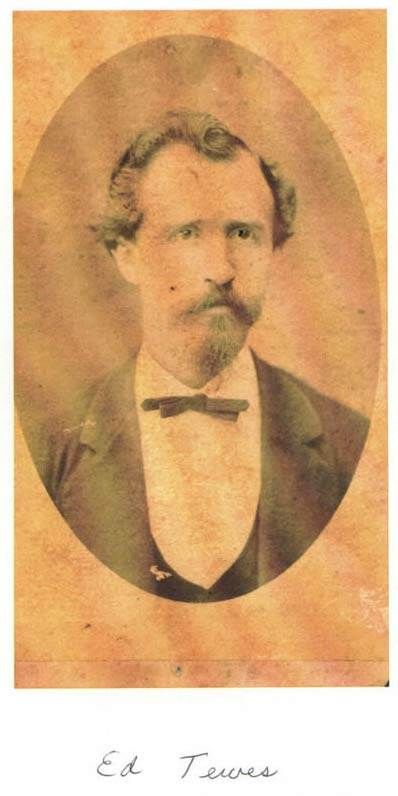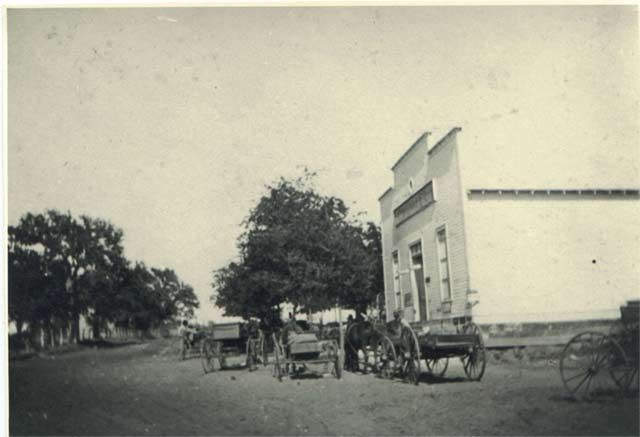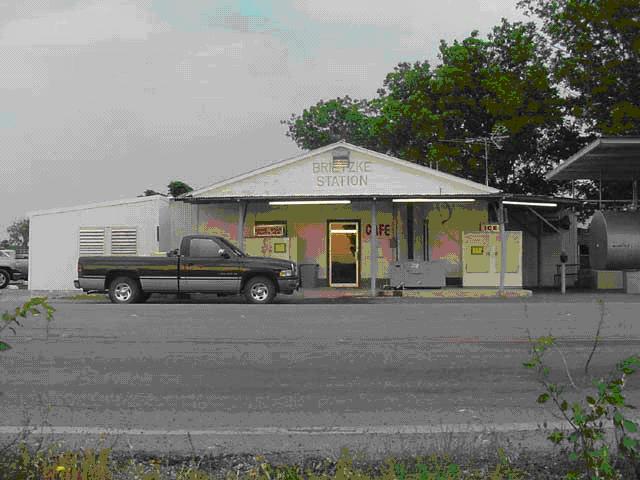
New Berlin
Texas
 (New Berlin Schoolhouse)
New Berlin, Texas of Guadalupe County wasn’t always a small town. After collecting historical information, I not only learned that my great, great, great grandfather Schultze was one of the founding fathers of New Berlin, but also that it was a very prosperous town.
In 1868 the Tewes, Muelders, and Schultze families came to this little town from Berlin Germany, thus naming it the town of “New Berlin.” Carl August Edward "Ed" Tewes had a great impact on the settlement and founding of the German community of New Berlin. He made significant contributions in education, commerce and government service. Tewes was born in Furstenberg, Germany on March 16, 1842. He immigrated to Texas at the age of 12 with his mother Christiana Emden Tewes, and his brothers and sisters. As had most of the German immigrants who settled in Central Texas, the family took a ship to Galveston and then a smaller boat to Indianola, Texas. Then they went by stagecoach to New Braunfels to join the father and older brother. His father, Louis Johann Christian Ludwig Tewes, had previously immigrated to Texas with his eldest son, William, on the ship Colchi in 1846. They had been in Texas eight years prior to the arrival of the rest of the family. Within a year (1854), Ed's mother died, probably of the dysentery epidemic of that time. She was buried at Yorktown. A year later (1855), Ed and his father were attacked by Commanches between the Cibolo Creek and San Antonio. Ed hid in a mesquite thicket and saved himself, but his father was scalped. Ed took his father's body to Lindenau in a wagon (a three-day journey) and buried him. He and his brother, Louis, were orphaned. Ed's half-sister Auguste, by then married, took Ed into her home. His other half-sister, Mattie, took Louis. Ed Tewes served in the Civil War for three years as a Confederate soldier. He was a member of Company One of the Third Texas Volunteers. He joined the regiment in San Antonio; the headquarters then were located where the Gunther Hotel now stands. As a member of the unit, he marched from San Antonio to Fort Ringold, Fort Brown, Fort Davis, and from there to Arkansas and on to Louisiana. After the war he returned to New Berlin and began building his sizable business holdings. His first store was so small it was called the Speckbox. Later, a larger store and dance hall were built. He was a self-made man and his wealth and influence in the New Berlin area can be clearly traced through records of his transactions at the Guadalupe County Courthouse, Seguin, Texas. In 1870 he purchased 137 acres on the Cibolo Creek from Rudolph Hellman. Family history indicated that the house was built prior to Tewes' marriage to Texanna Wooten Newton of Guadalupe County in 1876. Four children were born in the house: Annie, 1877; Walter Edward, 1878; Mary Auguste, 1879; Robert Emden, 1880.
As one of the original settlers, Tewes was instrumental in founding the town of New Berlin in 1868. Over the course of the next 15 years, he amassed 1,356 acres in and around the town of New Berlin. He established three general stores: one in New Berlin, one in La Vernia, and one in Karnes City. "In the Beginning: A History of Marion", indicates that after 1883, Tewes also had a store in Marion. He was appointed Postmaster of New Berlin on April 1, 1878 and held this position for 26 consecutive years. In 1891, he and several others petitioned the county to organize a school community at New Berlin. The petition was granted; New Berlin School Community #53 was established and the school was built on land donated by Tewes. Tewes was appointed as a trustee and served as such until he moved to San Antonio in 1894. His photo still hangs inside the school, which is now the Community Center of New Berlin. In 1894, Ed and Texanna Tewes moved with their children to the King William District of San Antonio. They kept the house in New Berlin. Emil Brietzke occupied the house and ran the store at New Berlin, but Tewes retained the room in the rear of the house for Tewes to stay in when he went to New Berlin to check the store. Tewes died in December of 1936, leaving the 'country home' at New Berlin to his son Walter, who had been born in what is now the kitchen of the house in 1878. He and his wife, Elsie Clara Wagner Tewes, owned and occupied the house for the remainder of their lives. After their deaths, the house was sold. It had been in the Tewes family for 100 years. Additionally, the house is architecturally significant because it exemplifies early Texas pioneer techniques using indigenous materials. It has been completely restored by the current owners, Mike and Kathy Hale following the guidelines for historic restoration. The house received Texas Historic Landmark designation in 1996 from the Texas Historical Commission and was listed on the National Register of Historic Places on January 9, 1997.
For the first couple of years the town’s population consisted only of the Tewes, Muelders, and Schultze families. However, in years to come more German immigrants moved to New Berlin to escape the draft taking place in Germany. After the population increased the town began to grow and prosper.
(New Berlin Schoolhouse)
New Berlin, Texas of Guadalupe County wasn’t always a small town. After collecting historical information, I not only learned that my great, great, great grandfather Schultze was one of the founding fathers of New Berlin, but also that it was a very prosperous town.
In 1868 the Tewes, Muelders, and Schultze families came to this little town from Berlin Germany, thus naming it the town of “New Berlin.” Carl August Edward "Ed" Tewes had a great impact on the settlement and founding of the German community of New Berlin. He made significant contributions in education, commerce and government service. Tewes was born in Furstenberg, Germany on March 16, 1842. He immigrated to Texas at the age of 12 with his mother Christiana Emden Tewes, and his brothers and sisters. As had most of the German immigrants who settled in Central Texas, the family took a ship to Galveston and then a smaller boat to Indianola, Texas. Then they went by stagecoach to New Braunfels to join the father and older brother. His father, Louis Johann Christian Ludwig Tewes, had previously immigrated to Texas with his eldest son, William, on the ship Colchi in 1846. They had been in Texas eight years prior to the arrival of the rest of the family. Within a year (1854), Ed's mother died, probably of the dysentery epidemic of that time. She was buried at Yorktown. A year later (1855), Ed and his father were attacked by Commanches between the Cibolo Creek and San Antonio. Ed hid in a mesquite thicket and saved himself, but his father was scalped. Ed took his father's body to Lindenau in a wagon (a three-day journey) and buried him. He and his brother, Louis, were orphaned. Ed's half-sister Auguste, by then married, took Ed into her home. His other half-sister, Mattie, took Louis. Ed Tewes served in the Civil War for three years as a Confederate soldier. He was a member of Company One of the Third Texas Volunteers. He joined the regiment in San Antonio; the headquarters then were located where the Gunther Hotel now stands. As a member of the unit, he marched from San Antonio to Fort Ringold, Fort Brown, Fort Davis, and from there to Arkansas and on to Louisiana. After the war he returned to New Berlin and began building his sizable business holdings. His first store was so small it was called the Speckbox. Later, a larger store and dance hall were built. He was a self-made man and his wealth and influence in the New Berlin area can be clearly traced through records of his transactions at the Guadalupe County Courthouse, Seguin, Texas. In 1870 he purchased 137 acres on the Cibolo Creek from Rudolph Hellman. Family history indicated that the house was built prior to Tewes' marriage to Texanna Wooten Newton of Guadalupe County in 1876. Four children were born in the house: Annie, 1877; Walter Edward, 1878; Mary Auguste, 1879; Robert Emden, 1880.
As one of the original settlers, Tewes was instrumental in founding the town of New Berlin in 1868. Over the course of the next 15 years, he amassed 1,356 acres in and around the town of New Berlin. He established three general stores: one in New Berlin, one in La Vernia, and one in Karnes City. "In the Beginning: A History of Marion", indicates that after 1883, Tewes also had a store in Marion. He was appointed Postmaster of New Berlin on April 1, 1878 and held this position for 26 consecutive years. In 1891, he and several others petitioned the county to organize a school community at New Berlin. The petition was granted; New Berlin School Community #53 was established and the school was built on land donated by Tewes. Tewes was appointed as a trustee and served as such until he moved to San Antonio in 1894. His photo still hangs inside the school, which is now the Community Center of New Berlin. In 1894, Ed and Texanna Tewes moved with their children to the King William District of San Antonio. They kept the house in New Berlin. Emil Brietzke occupied the house and ran the store at New Berlin, but Tewes retained the room in the rear of the house for Tewes to stay in when he went to New Berlin to check the store. Tewes died in December of 1936, leaving the 'country home' at New Berlin to his son Walter, who had been born in what is now the kitchen of the house in 1878. He and his wife, Elsie Clara Wagner Tewes, owned and occupied the house for the remainder of their lives. After their deaths, the house was sold. It had been in the Tewes family for 100 years. Additionally, the house is architecturally significant because it exemplifies early Texas pioneer techniques using indigenous materials. It has been completely restored by the current owners, Mike and Kathy Hale following the guidelines for historic restoration. The house received Texas Historic Landmark designation in 1996 from the Texas Historical Commission and was listed on the National Register of Historic Places on January 9, 1997.
For the first couple of years the town’s population consisted only of the Tewes, Muelders, and Schultze families. However, in years to come more German immigrants moved to New Berlin to escape the draft taking place in Germany. After the population increased the town began to grow and prosper.

Many new industries began to spread throughout the town. Of them, the Muelder’s grocery store was the most prosperous. This store sold everything the people of New Berlin could want or need. George Muelder’s place was far more than a place to buy staples and supplies. It was where people came at the end of a workday to visit and swap stories, lies and jokes over a beer or two. It was where you came to find out what was going on in the community, to discuss crops and cattle, to have important papers notarized (Muelder read every word of every document before he signed the notary’s affidavit), to pick up your mail if your box was one of those located in front of the store, to drop off mail for the mail carrier if you weren’t on his route. If you were interested in the oil business, it was a place you could discuss core samples, underground formations, drilling, leasing, or the latest on whose well was producing what with George; a lifetime of chasing oil had given him a wealth of information, if not of "black gold." It was, as the theme song for the TV show Cheers went, a place "where everybody knows your name." If you’d ever been there before, George Muelder would remember you. He’d greet you with a smile and a handshake, and make you feel at home. He knew your kids, too, and would often give them a piece of candy or bubblegum from the old glass candy jar beside the meat counter. Then they would probably notice one of the ever-present kittens that usually came into the world inside one of the large boxes in a darkish corner of the store. If George was lucky, some of those kittens would go home with some of those kids. Many, however, grew to cathood and stayed on, greeting him on the back porch each morning, sharing his lunch, napping in his lap, and eating the majority of the cat food he stocked. Dogs, too, found a home at Muelder Store, especially if they liked cat food. He never went for fancy names; they were "Gray Cat," "Mama Cat," "Old Yeller Cat," "Little Puppy." His favorite stray dog, though, did get a name: Brownie. It truly was the favorite place to be in New Berlin.

Walter Brietzke, another popular entrepreneur, owned a very popular car dealership. Among the many other growing businesses were Brietzke’s Station, a meat market, a blacksmith shop, a bowling alley, a dance hall, and three schools.
New Berlin’s community was pleasant and multi-racial. The kids of the town grew up playing together despite their race. However, most white kids attended school near Blue Creek Road, the African American kids attended school near Sweet Home Road and the Mexican American kids attended school outside New Berlin. This segregation had little to do with race and more to do with language barriers.
For many years New Berlin continued being a pleasant and prosperous town. That is, until one morning in the spring of 1946, George and Betty Muelder awoke to the devastating news that their store and family home had burned to the ground. Roger recalls that his father had roused him from bed because there were noises coming from the store. It sounded as if things were being thrown from the shelves, as someone would shuffle through things during a robbery. "Get your pants on!" cried Edgar, and the father and son ran to the store with a shotgun, but saw flames flickering out beneath the building. Shortly thereafter the entire structure was ablaze. They had no hope of salvaging the store or anything in it. Because it had been a dry year, there was not enough water to fight the fire. The house sat right next to the store and seemed certain to burn. They worked as fast as they could to empty all 16 rooms of the house. They managed to rescue the contents of all but two rooms, including a piano and the toilet (an unusual luxury in New Berlin at that time.) The heat was so intense that an Oldsmobile they had pushed away from the house had the paint burned off it on the side nearest the fire. The fire department had not been called because the only phone was in the store. By the time word had reached Marion and the fire trucks neared at dawn, the store and house had burned virtually to the ground.
Glass bottles were melted into grotesque shapes by the intense heat. The safe could not be opened for about six weeks because exposure to oxygen would have caused the contents to ignite. With the home went much of the family’s irreplaceable memorabilia. The exact cause of the fire was never determined; however, because of the intense thunderstorm which had occurred that night, lightning was the primary suspect.
More than 100 years later, none of these businesses exist, except Brietzke Station. Brietzke Station is an institution in New Berlin. If you say you’re from New Berlin, people say, “Oh, you have that little café out there, Brietzke’s.” It is currently famous for the fish specials on Wednesday and Friday nights. Big John and Mutsie Bohannon have owned and operated the Station since 1977.
The building that houses what is currently the café has a long and varied history. It has been several things, but it has always been of central importance to this small community. It has always been a gathering place. The owners have always been sociable and have not objected to the locals hanging around.

After the Muelder’s store burned down, the once booming town of New Berlin slowly began to fade. The population today consists of nearly 200 people, all of which know each other and take pride in their small, pleasant town of
New Berlin, Texas
Interview with Herman Doege
ANNOTATED BIBLIOGRAPHY:
Texas Handbook: This website offered me some good information about New Berlin, and when it was founded. It also had information about some people who lived there before.
New Berlin Texas. org: This website also had a lot of information regarding the families who founded New Berlin. It also contained information on the businesses in New Berlin.
Return to
Small Town Research Projects Index





